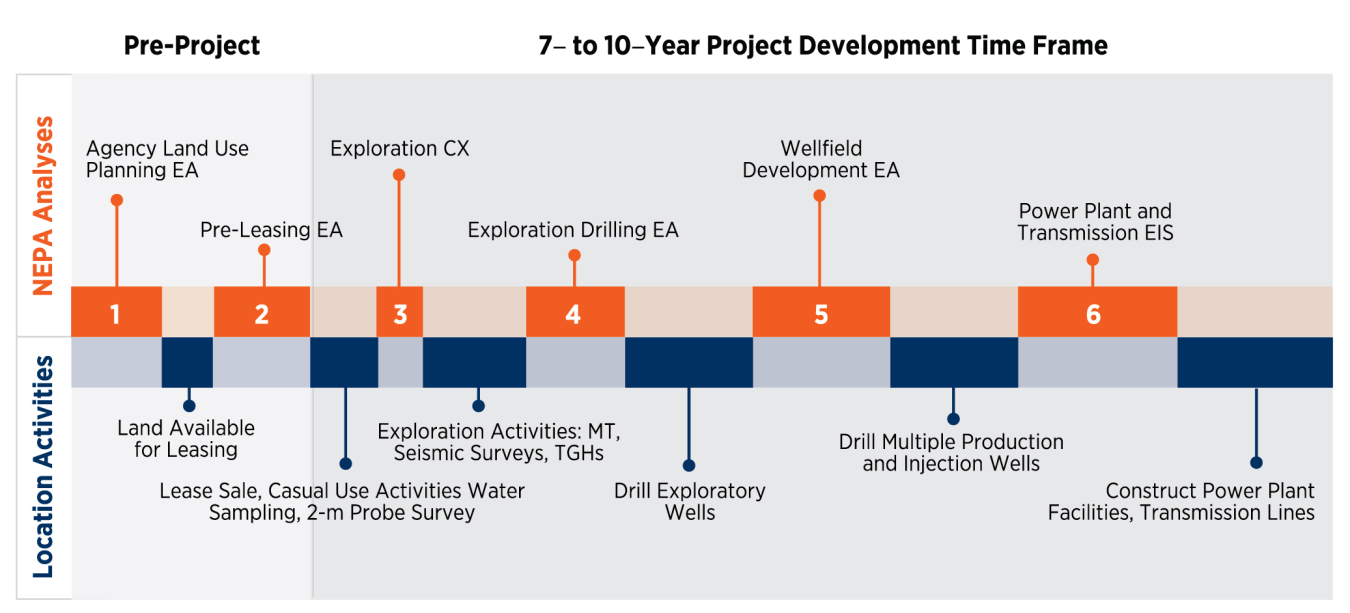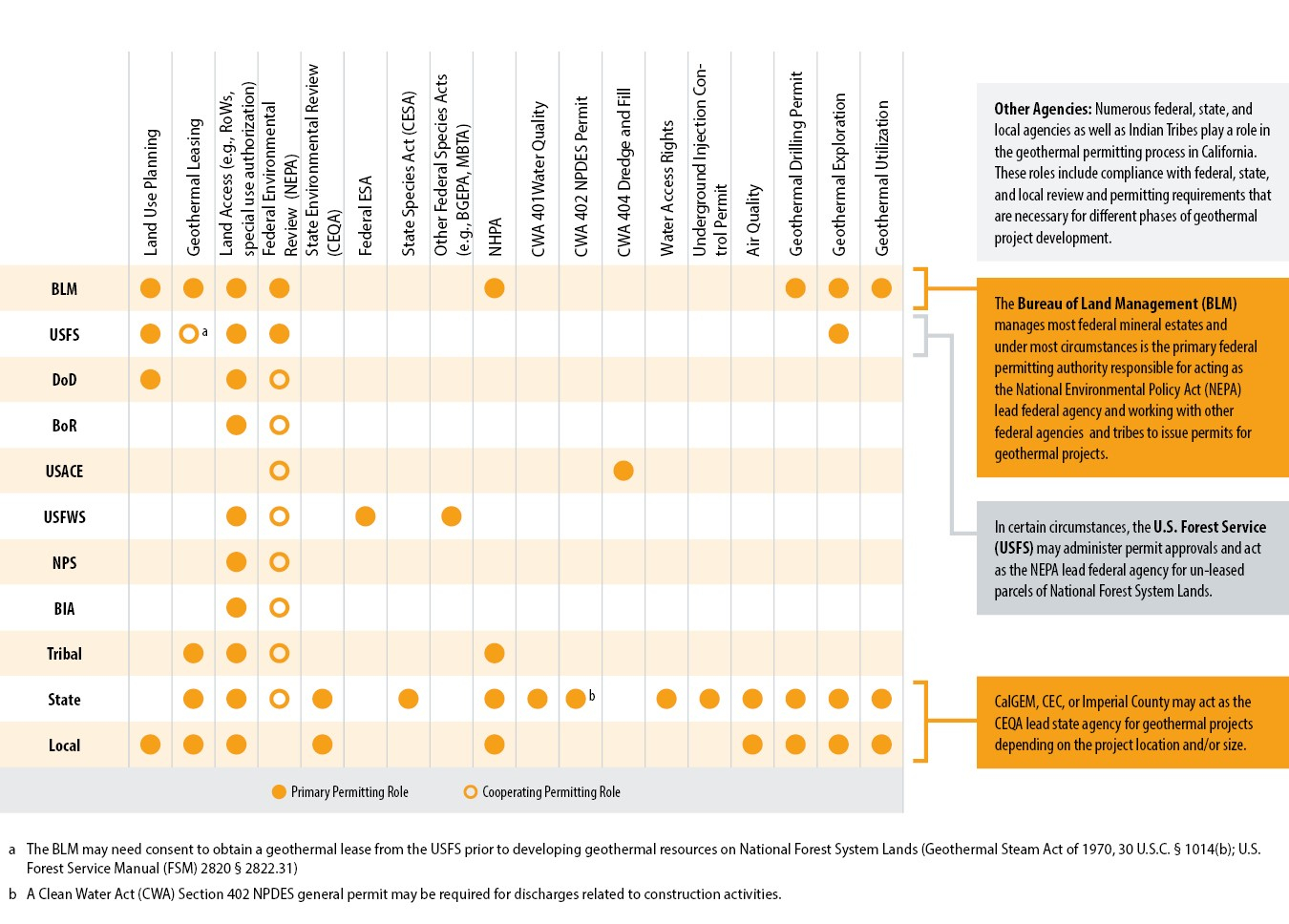Geothermal project development can be subject to numerous permits, authorizations, and other regulatory requirements in the United States at different project phases and levels of government. These permitting and regulatory requirements are necessary to address potential impacts to land use, water quality and usage, and much else, but may also act as non-technical barriers to geothermal project development, affecting project timelines, costs, and risks.
The Bureau of Land Management’s (BLM) Geothermal Guidance website is the primary source of information related to permitting for geothermal power development projects. It contains a repository of reading material and information for the BLM’s geothermal program, including guidance for exploration development, frequently asked questions, and more.
Explore the resources on this page to get helpful guidance on understanding and addressing the permitting process for geothermal power development projects.
The Potential in Permitting
As part of the U.S. Department of Energy’s 2019 GeoVision analysis, the GeoVision Analysis Supporting Task Force Report: Barriers analyzed the non-technical barriers to geothermal deployment and potential improvement scenarios. The modeling in this report indicates that, through an expanded Categorical Exclusion for Exploration Drilling and a Centralized Permitting Office, the resulting project timeline reductions could lead conventional geothermal power capacity to achieve in excess of 12GW by 2050 – a 113% improvement over the Business as Usual (BAU) baseline.
Modeled improvement in timelines. Improvement Scenario 2a results in 4.4 GW, or 74%, over BAU, while Improvement Scenario 2b results in 6.7 GW, or 113%, over BAU. Source: GeoVision Analysis Supporting Task Force Report: Barriers
Figure Note: CX = categorical exclusion, IRT = Improved Regulatory Timeline.
More recently, legislation through the Energy Act of 2020 mandated the formation of centralized permitting offices under the Bureau of Land Management (BLM) National Renewable Energy Coordination Office. BLM Information Bulletin 2022-040 outlines the structure of the coordination offices established across the western United States.
To learn more, explore the GeoVision analysis, which includes the examination of key regulatory, permitting, and land-access barriers to geothermal development.
Environmental Review
Stakeholders embarking on a geothermal power development project must navigate environmental review requirements under the National Environmental Policy Act of 1969 (NEPA), as well as the federal, state, and local agencies’ regulatory roles. A geothermal power development project on federal land can require multiple phases of environmental review under NEPA, including land use planning, leasing, exploration, drilling, and utilization operations.

Example timeline of a geothermal project on federal lands, illustrating that a single location could trigger National Environmental Policy Act analysis six separate times. Source: GeoVision analysis
Figure Note: EA = Environmental Assessment, EIS = Environmental Impact Statement, CX = categorical exclusion, MT = magnetotelluric, and TGH = temperature-gradient hole.
Review the GeoVision analysis for more information on federal regulations related to geothermal power development projects.
In addition to federal regulations, geothermal projects may be subject to environmental review at the state and local levels, for instance the California Environmental Quality Act (CEQA) requirements. Tables 6 and 7 below from the National Renewable Energy Laboratory (NREL) Non-Technical Barriers to Geothermal Development in California and Nevada depict agency and tribal government roles in the geothermal regulatory process in Nevada and Imperial County, California.

Federal Agency, State Agency, Local Agency, and Tribal Geothermal Regulatory Roles in Imperial County, California
For more on state and local regulations, read the Non-Technical Barriers to Geothermal Development in California and Nevada report, or explore the State Specific Resources on BLM’s Geothermal Guidance website.
Permitting and Regulatory Improvements
Firm electricity generation like that provided by geothermal will become particularly important to help balance the changing and expanding grid; despite this, deployment of new geothermal plants has been slow. GTO funded Lawrence Berkeley National Laboratory (LBNL) to conduct an analysis quantifying disparities in historical deployment, resulting in Mind the Gap: Comparing the Net Value of Geothermal, Wind, Solar, and Solar+Storage in the Western United States. This resource quantified the dramatic difference between prices for geothermal power purchase agreements and related wholesale market value, illustrating that geothermal is significantly undervalued, especially when accounting for the services it provides to the grid. Projects funded under the GRID funding opportunity, prompted by this analysis, will further illustrate geothermal’s value and help utilities and regulatory bodies understand geothermal’s contributions to the grid.
GTO’s Topics and Considerations for Developing State Geothermal Regulations report provides a resource for all states, inclusive of all geothermal power and heating technologies, to inform the development of geothermal regulations. GTO, in collaboration with partners at the National Renewable Energy Laboratory, convened a Geothermal Regulatory Stakeholder Working Group to advise and review the geothermal regulatory synthesis as it was in development. This report, which includes a catalogue of existing state and federal geothermal regulations as well as best practices from geothermal and related industries, has seen 10x more unique downloads in the first six months since release compared with similar GTO publications released in the past decade.
The Salton Sea Geothermal Development: Nontechnical Barriers to Entry—Analysis and Perspectives report found that permitting costs play only a minor role in determining the viability of geothermal development in this location. Other factors such as permitting timelines, government/agency coordination, and the potential colocation of lithium extraction with a geothermal plant may result in much larger impacts on project viability. Based on these findings, the analysis also includes recommendations to streamline geothermal development in the Salton Sea region and beyond.
GTO funded the Non-Technical Barriers to Geothermal Development in California and Nevada and the Economic Impact of Permitting Timelines on Geothermal Power in California, Nevada, and Utah studies to deliver analyses specific to those states, where geothermal power generation is already present but there is significant potential for more. These studies identified numerous state-specific barriers; for example, geothermal permitting timelines can vary from six months to several years depending on biological resources, cultural resources, and sensitive environmental issues at a project site.
GTO convened, supported, and participated in the Bureau of Land Management (BLM) and GTO co-led Renewable Energy Coordination Office (RECO) Interagency Geothermal Permitting Working Group (IGPWG) to improve geothermal project permit coordination in support of the RECO and the Biden Administration’s renewable energy targets on public land. The IGPWG is acting on a select set of actions from the 2022 Geothermal Interagency Collaboration Task Force: Summary of Findings, which recaps themes and recommendations drawn from Tribes, Tribal organizations, environmental non-government organizations, industry, and state and federal agencies during listening sessions, meetings, and stakeholder forums related to geothermal regulatory approvals and permitting. The IGPWG hosted multiple forums in 2023 and 2024, which resulted in a forthcoming set of attainable actions local, state, and federal agencies can take to accelerate geothermal development on public and Tribal lands.
GTO's Publications and Technical Resources
Check out GTO’s collection of Technical Resources for more sources of federal and state permitting information, access to renewable energy data, cost and performance modeling tools, and much more to help in your geothermal permitting process.
You can also dig deeper into non-technical barrier reports, GTO’s strategic plan, market reports, and other publications on GTO’s Geothermal Publications page.
Further Resources
For additional background information, research, and guidance for geothermal power development projects, refer to the resources at the following links:
- OpenEI Geothermal Energy NEPA page
- Geothermal Data Repository: Search for ‘Permitting’ or ‘Non-Technical Barriers.’ Recent examples of GTO-funded non-technical barriers analysis work include:
- Environmental Analysis

